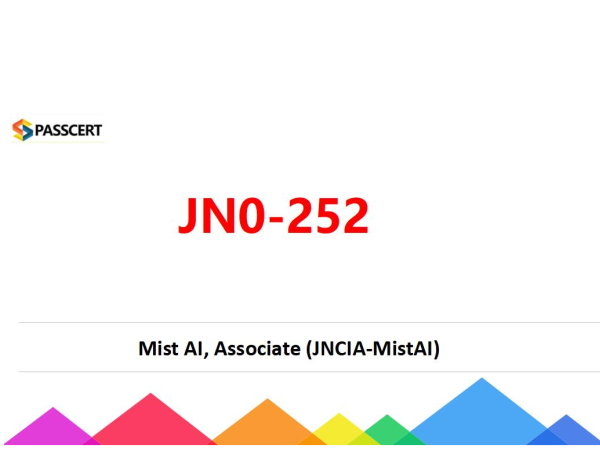Introduction
JN0-252 is a new Mist AI, Associate Exam for the Juniper Networks Certified Associate, Mist AI (JNCIA-MistAI) certification. Passcert has recently provided comprehensive Mist AI, Associate (JNCIA-MistAI) JN0-252 Dumps designed to simulate real exam scenarios that will help you gain a deep understanding of what you can expect during the actual exam. Not only does it provide you with the knowledge needed to pass the exam, but it also cultivates the confidence you need to navigate through it effectively. We strongly recommend that you utilize our Mist AI, Associate (JNCIA-MistAI) JN0-252 Dumps multiple times, as this repeated exposure will ensure a solid grasp of the material and maximize your chances of success in the actual Juniper JN0-252 exam.
Mist AI, Associate (JNCIA-MistAI)
The Mist AI track enables you to demonstrate a thorough understanding of WLAN technology in general and the Mist AI features and functionality. JNCIA-MistAI, the associate-level certification in this track, is designed for Wireless LAN networking professionals with introductory knowledge of wireless networking using the Mist AI. The written exam for the certification verifies your basic understanding of WLAN and Mist AI technology, features, and functionality.
This track contains three certifications:
JNCIA-MistAI: Mist AI, Associate. (JN0-251)
JNCIS-MistAI-Wireless: Mist AI Wireless, Specialist. (JN0-451)
JNCIS-MistAI-Wired: Mist AI Wired, Specialist. (JN0-460)
Exam Details
Exam Code: JN0-252
Prerequisite Certification: None
Delivered by Pearson VUE
Exam Length: 90 minutes
Exam Type: 65 multiple-choice questions
Exam Objectives
Juniper Mist Cloud Fundamentals
Identify fundamental concepts about the Juniper Mist cloud-native architecture, including:
● AI concepts
● Machine learning
● Benefits of using cloud-based management
● Juniper Mist cloud capabilities and use cases
Juniper Mist Configuration Basics
Identify the concepts or functionality of Juniper Mist AI accounts, including:
● Creation and management of user accounts
● Capabilities of different account roles
● Juniper Mist Cloud user/account authentication methods
Describe the concepts or functionality of Juniper Mist AI initial configurations, including:
● Factory default configurations and network connection prerequisites
● Device claiming and onboarding
● Creation and management of Juniper Mist organizations and sites
● Template usage
● Labels and policies
Identify the concepts or functionality of Juniper Mist AI advanced configurations, including:
● Subscriptions (Licensing)
● Certificates (Radsec, Mist)
● Auto provisioning
Juniper Mist Network Operations and Management
Identify concepts or functionality of Juniper Mist wireless network management and operations features:
● Benefits and features of Juniper Mist Wi-Fi Assurance
Identify concepts or functionality of Juniper Mist wired network management and operations features:
● Benefits and features of Juniper Mist Wired Assurance
● Benefits and features of Juniper Mist WAN Assurance
Juniper Mist Monitoring and Analytics
Identify the concepts or components of Juniper Mist AI monitoring and analytics, including:
● SLEs
● Packet captures
● Juniper Mist insights
● Alerts
● Audit logs
Marvis Virtual Network Assistant AI
Identify the concepts or functionality of Marvis AI, including:
● Marvis actions (org-level, site-level)
● Marvis queries
Location-based Services
Identify the concepts or components of Location-based Services (LBS), including:
● Juniper Mist vBLE concepts (ie. asset visibility, vBLE engagement)
Juniper Mist Cloud Operations
Identify the concepts or components of Juniper Mist APIs
● RESTful
● Websocket
● Webhook
Identify the options of Juniper Mist support
● Support tickets
● Update information
● Documentation
1. Where can user-defined labels be applied in the Mist UI?
A. A WLAN
B. An Organization
C. A Site
D. A WXLAN Policy
Answer: D
2. At which two levels can labels be created? (Choose two.)
A. Organization-level
B. Switch level
C. Site-level
D. Access Point level
Answer: A, C
Which Mist location-based feature would be used for wayfinding?
A. Wi-Fi 6
B. Asset Visibility
C. vBLE Engagement
D. Wi-Fi Location
Answer: C
4. Which administrator role must you have to view audit logs?
A. Installer
B. Network Admin
C. Super User
D. Observer
Answer: B
5. Which SLE would you use to determine Wi-Fi interference?
A. AP Uptime
B. Roaming
C. Successful Connects
D. Capacity
Answer: D
6. Which statement is correct about Mist SLEs?
A. A Mist classifier is comprised of multiple SLEs.
B. A Mist SLE is comprised of multiple classifiers.
C. A Mist classifier is comprised of a single SLE.
D. A Mist SLE is comprised of a single classifier.
Answer: B
7. Which two statements are correct regarding WXLAN policies? (Choose two.)
A. WLAN templates are used to create site-level policies
B. If policies are defined at both the organization and site level, site-level policies will always be handled first
C. WLAN templates are used to create organization-level policies
D. If policies are defined at both the organization and site level, organization-level policies will always be handled first
Answer: C, D
8. What are two categories that machine learning models are grouped into? (Choose two.)
A. Reinforcement learning
B. Natural Language Processing
C. Supervised learning
D. Vision
Answer: A, C
9. Which two technologies are available to use in LBS? (Choose two.)
A. Gyroscope
B. WLAN
C. GPS
D. Doppler
Answer: B, C
10. The Connectivity category in Marvis Actions displays connectivity failures for which devices?
A. WAN edge and wireless
B. wireless only
C. WAN edge and wired
D. wireless and wired
Answer: DYoutube
Matériaux
Outils
Étape 1 -
Draft

 Français
Français English
English Deutsch
Deutsch Español
Español Italiano
Italiano Português
Português